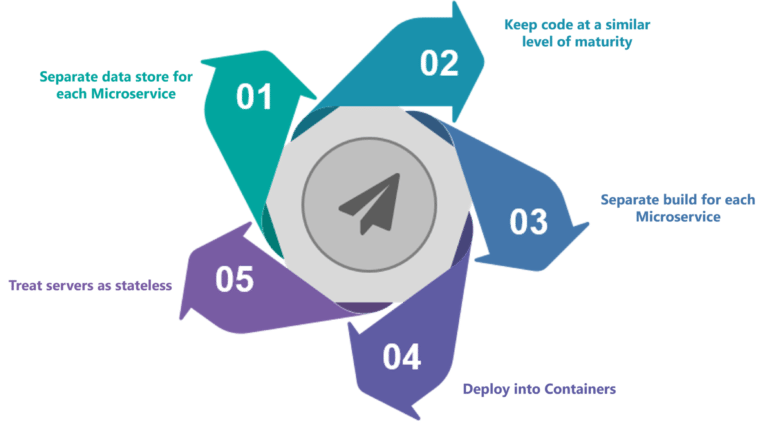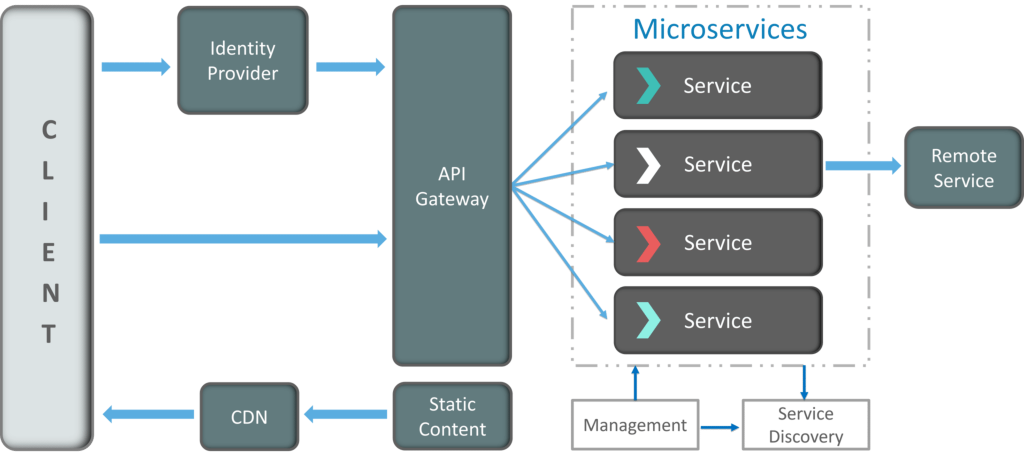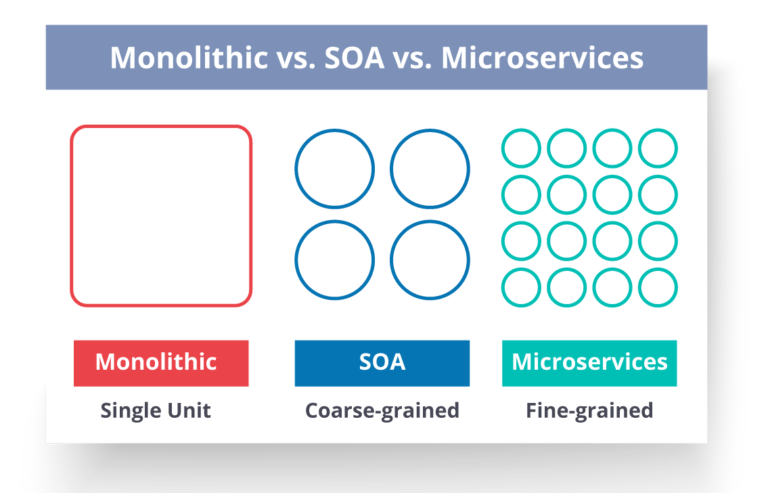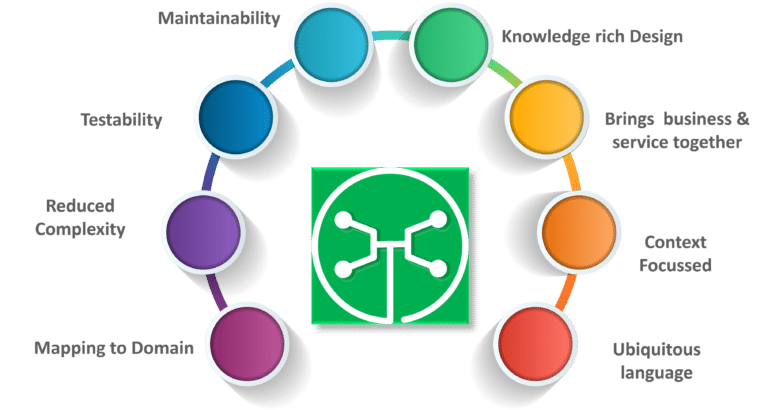Make a list of the benefits of Microservices Architecture.
- Independent Development-Based on their individual functionality, all microservices can be easily developed.
- Independent Deployment-They can be deployed individually in any application based on their services.
- Fault Isolation-Even if one of the application’s services fails, the system continues to run.
- Different languages and technologies can be used to build different services of the same application using a mixed technology stack.
- Individual components can scale as needed; there is no need to scale all components at the same time.
What are your thoughts on Microservices?
- Microservices, also known as Microservice Architecture, is an architectural style in which an application is structured as a collection of small autonomous services based on a business domain.
- In layman’s terms, you’ve probably seen bees align hexagonal wax cells to build their honeycomb.
- They start with a small section made of various materials and work their way up to a large beehive.
- These cells form a pattern, forming a strong structure that holds a section of the beehive together.
- Each cell is independent of the others, but they are also related to one another.
- This means that damage to one cell has no effect on the other cells, allowing bees to rebuild these cells without affecting the entire hive.
What distinguishes Microservices from other types of software?
- Decoupling – Within a system, services are largely decoupled. As a result, the entire application can be easily built, modified, and scaled.
- Microservices are treated as self-contained components that can be easily replaced and upgraded.
- Microservices focus on a single capability and are very simple.
- Autonomy – Developers and teams can work independently of one another, resulting in faster development times.
- Continuous Delivery – Enables frequent software releases by automating the creation, testing, and approval of software.
- Microservices aren’t focused on projects as much as they are on applications. Instead, they treat applications as if they were finished products for which they are accountable.
- Decentralized Governance – The emphasis is on selecting the appropriate tool for the job. That is to say, there is no standardized or technological pattern. Developers have complete control over which tools they use to solve their problems.
- Microservices facilitate agile development. Any new feature can be developed quickly and then discarded.
What are the best Microservices design practices?
The best practices for designing microservices are as follows:

What is Microservice Architecture and how does it work?
The following elements make up a microservice architecture:

- Clients – Requests are sent by various users on various devices.
- Identity Providers – Verifies the identity of users or clients and issues security tokens.
- Client requests are handled by the API Gateway.
- Static Content – Stores all of the system’s content.
- Management – Maintains service balance on nodes and detects failures.
- Service Discovery is a method for determining the communication path between microservices.
- Content Delivery Networks (CDNs) – A network of proxy servers and their data centres that is distributed across the internet.
- Remote Service – Allows remote access to information stored on a network of computers.
Name three commonly used Microservices tools.
Important Microservices tools include 1.) Wiremock, 2.) Docker, and 3.) Hysrix.
What are the pros and cons of Microservice Architecture?
Pros of Microservice Architecture:
Use of various technologies is allowed.
Each microservice concentrates on a single function.
Individually deployable units are supported.
Allow for regular software updates.
Ensures that each service is secure.
Several services are being developed and deployed at the same time.
Cons of Microservice Architecture:
Increases the difficulty of troubleshooting
Due to remote calls, there is an increase in delay.
Increased configuration and other operations efforts
Maintaining transaction security is difficult.
It’s difficult to keep track of data across multiple boundaries.
It’s challenging to code between services.
What is the difference between Monolithic, SOA and Microservices Architecture?

- Monolithic Architecture resembles a large container in which all of an application’s software components are assembled and tightly packaged.
- A Service-Oriented Architecture (SOA) is a collection of interconnected services. The communication can be as simple as data passing or as complex as two or more services cooperating on a task.
- Microservice Architecture is an architectural style in which an application is structured as a collection of small autonomous services based on a business domain.
What are some of the difficulties you encounter when working with Microservice Architectures?
While it may appear that creating a number of smaller microservices is simple, the following challenges are frequently encountered while doing so.
- Automate the Components: Because there are so many smaller components, automating them is difficult. As a result, we must follow the Build, Deploy, and Monitor stages for each component.
- Perceptibility: Deploying, maintaining, monitoring, and identifying problems with a large number of components becomes difficult. It necessitates a high level of perceptibility around all of the components.
- Configuration Management: Keeping track of component configurations across multiple environments can be difficult at times.
- Debugging: Finding each and every service for an error is difficult. To debug problems, it’s critical to keep centralised logging and dashboards.
What distinguishes Microservices from other types of software?
The following are some of the characteristics of microservices:

What is Domain Driven Design, and how does it work?

Why is Domain Driven Design (DDD) necessary?

What is the definition of ubiquitous language?
If you need to define the Ubiquitous Language (UL), it is a common language used by developers and users of a specific domain to easily explain the domain.
The universal language must be crystal clear in order to bring all team members on board and to translate in a way that a machine can understand.
What is the definition of cohesion?
Cohesion refers to the degree to which the elements within a module fit together.
What is the definition of coupling?
Coupling is a metric for the strength of interdependencies between components. High Cohesion and Low Coupling are always said to be characteristics of a good design.
What is REST/RESTful and what are the benefits of using it?
RESTful web services/Representational State Transfer (REST) is an architectural style for allowing computer systems to communicate over the internet. This simplifies the understanding and implementation of microservices.
Microservices can be built with or without RESTful APIs, but RESTful APIs make it much easier to build loosely coupled microservices.
What are your thoughts on Spring Boot?
It’s a well-known fact that as new functionalities have been added, spring has become increasingly complex. If you’re starting a new spring project, you’ll need to configure the application server, add maven dependencies, and add spring configuration. As a result, everything must be done from the ground up.
The solution to this issue is Spring Boot. You can avoid all the boilerplate code and configurations by using spring boot. Consider yourself as if you’re baking a cake: spring represents the ingredients needed to make the cake, and spring boot represents the finished product in your hand.
In Spring Boot, what is an actuator?
The Spring Boot actuator provides restful web services for accessing the current state of an application in production. You can check various metrics and monitor your application with the help of actuator.
What is the meaning of Spring Cloud?
Spring Cloud, according to its official website, “provides tools for developers to quickly build some of the most common patterns in distributed systems” (e.g. configuration management, service discovery, circuit breakers, intelligent routing, leadership election, distributed sessions, cluster state).
What issues does Spring Cloud address?
We encounter a few issues while developing distributed microservices with Spring Boot, which are addressed by Spring Cloud.
- Network issues, latency overhead, bandwidth issues, and security issues are all examples of the complexity associated with distributed systems.
- Service Discovery – Service discovery allows processes and services in a cluster to find and communicate with one another.
- Redundancy issues have been resolved – Redundancy issues are common in distributed systems.
- Load balancing – Ensures that workloads are distributed evenly across multiple computing resources, such as a computer cluster, network links, and central processing units.
- Reduces performance issues – As a result of various operational overheads, performance issues are reduced.
Can you give me a quick overview of Rest and Microservices?
REST
Microservices can be implemented in a variety of ways, but one method is to use REST over HTTP. REST is also used to serve business data in other applications such as web apps, API design, and MVC applications.
Microservices
Microservices is a system architecture in which all of the system’s components are separated into individual components that can be built, deployed, and scaled independently. Microservices have certain principles and best practises that aid in the development of a resilient application.
In a nutshell, REST is a method for constructing Microservices.
What are the various types of Microservices tests?
As there are multiple microservices working together, testing becomes quite complex when working with microservices. As a result, tests are divided into various levels.
Technology-facing tests, such as unit tests and performance tests, are at the bottom of the hierarchy. These are entirely computerised.
We have tests for exploratory testing at the middle level, such as stress tests and usability tests.
We have a small number of acceptance tests at the top level. Stakeholders can use these acceptance tests to better understand and verify software features.
What exactly do you mean when you say “distributed transaction”?
Any situation in which a single event causes the mutation of two or more separate sources of data that cannot be committed atomically is referred to as a distributed transaction. It gets even more complicated in the world of microservices because each service is a unit of work, and most of the time multiple services must work together to make a business successful.
What is Bounded Context, and what does it mean?
In Domain-Driven Design, a central pattern is Bounded Context. It’s the focus of DDD’s strategic design section, which focuses on large models and teams. Large models are dealt with in DDD by dividing them into different Bounded Contexts and explicitly stating their inter-relationships.
What is Idempotence and how does it work?
Idempotence is the property of being able to do something twice with the same result, i.e. as if it had only been done once.
Idempotence is used at the remote service or data source so that it only processes the instruction once when it receives it multiple times.

 Starting: 1st of Every Month
Starting: 1st of Every Month  +91 8409492687
+91 8409492687  Contact@DevOpsSchool.com
Contact@DevOpsSchool.com
